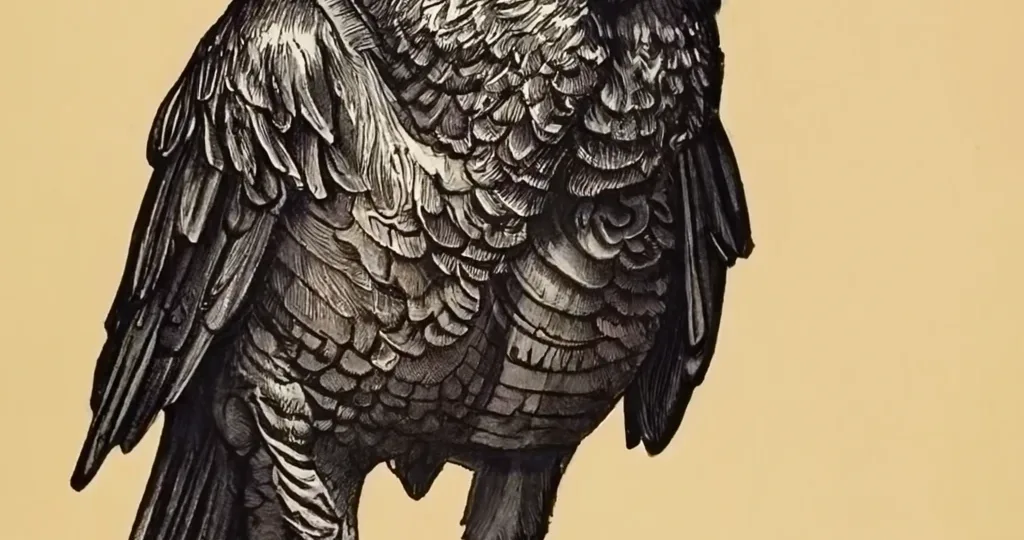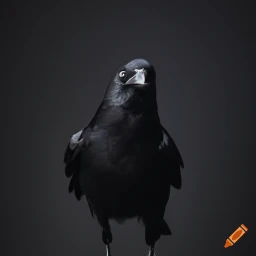Discover the Secret Life of Corvus Macrorhynchos – Eastern Asias Black Beauty
December 30, 2023 | by BlackCrow.com

Meet the Corvus Macrorhynchos
Introduction to the Corvus Macrorhynchos
The Corvus Macrorhynchos, also known as the large-billed crow, is a fascinating bird native to Eastern Asia. It belongs to the crow family, which is known for its intelligence and adaptability. With its distinctive appearance and intriguing behaviors, the Corvus Macrorhynchos has captured the attention of bird enthusiasts and researchers alike.
These black beauties are highly adaptable and can be found in a variety of habitats, including forests, farmlands, and urban areas. Their adaptability allows them to thrive in diverse environments, making them one of the most widespread crow species in the region.
Physical Characteristics of the Corvus Macrorhynchos
The Corvus Macrorhynchos is a medium-sized bird with striking features. Here are some key physical characteristics:
- Size: On average, these crows measure about 45-59 centimeters (18-23 inches) in length, including their long tail feathers.
- Color: The plumage of the Corvus Macrorhynchos is predominantly black, with a glossy sheen. Their feathers may appear iridescent under sunlight.
- Bill: One of the most distinctive features of the Corvus Macrorhynchos is its large and robust bill. The bill is slightly curved and measures around 5-7 centimeters (2-2.8 inches) in length. This powerful tool allows them to forage for a variety of food sources.
- Eyes: Their eyes are dark and exhibit a high level of intelligence. The keen eyesight of the Corvus Macrorhynchos helps them locate food and detect potential threats.
- Voice: The Corvus Macrorhynchos has a wide range of vocalizations, including caws, calls, and various vocal mimicries. Their vocal repertoire is used for communication within their social groups.
The physical characteristics of the Corvus Macrorhynchos make it an impressive and visually striking bird. Its unique bill and vibrant plumage contribute to its charismatic presence in the avian world.
Learning about the Corvus Macrorhynchos is just the beginning of unraveling the mysteries surrounding these remarkable creatures. In the next sections, we will delve deeper into their habitat, behaviors, ecological role, and more. Stay tuned to discover the secret life of the Corvus Macrorhynchos!
Habitat and Distribution
The Corvus Macrorhynchos, also known as the large-billed crow, has a wide range and can be found in various habitats across Eastern Asia.
Range of the Corvus Macrorhynchos
The Corvus Macrorhynchos is native to Eastern Asia and is found in countries such as China, Japan, Indonesia, Malaysia, and the Philippines. Its range extends from northeastern India and northern Myanmar to Taiwan and the Ryukyu Islands. It is also present in parts of the Russian Far East.
Preferred Habitats of the Corvus Macrorhynchos
The Corvus Macrorhynchos is a highly adaptable species that can thrive in a range of habitats. It is commonly found in forests, woodlands, open grasslands, agricultural areas, and urban environments. These crows are known to be versatile and can easily adapt to human-altered landscapes.
They are often seen near farmlands, where they can scavenge for food and take advantage of agricultural resources. The Corvus Macrorhynchos is also known to inhabit coastal areas, where it can feed on marine invertebrates and carrion.
The presence of the Corvus Macrorhynchos in both natural and human-dominated habitats highlights its ability to adapt and utilize available resources. These crows are highly intelligent and have successfully adapted to the changing landscapes of Eastern Asia.
Understanding the habitat preferences and distribution of the Corvus Macrorhynchos is essential for conservation efforts and ensuring the continued survival of this remarkable species.
The Secret Life of the Corvus Macrorhynchos
The Corvus Macrorhynchos, also known as the large-billed crow, has a fascinating secret life. Let’s explore its social behavior and communication, feeding habits and diet, as well as its breeding and nesting habits.
Social Behavior and Communication
Corvus Macrorhynchos is a highly sociable bird and is often found in large groups called flocks or murders. Within these flocks, they engage in complex social interactions. They communicate with each other using a variety of vocalizations, including calls, caws, and clicks. Each vocalization carries a specific meaning, allowing them to convey messages about food sources, potential dangers, or to establish their territory.
These crows also exhibit remarkable problem-solving abilities and have been observed using tools to extract food hidden in hard-to-reach places. They can communicate and coordinate their actions with other members of the group, which highlights their high level of intelligence and social cooperation.
Feeding Habits and Diet
The Corvus Macrorhynchos has an omnivorous diet, meaning it consumes both plant and animal matter. They are opportunistic feeders and have a wide-ranging palate. Their diet includes fruits, seeds, nuts, insects, small vertebrates, carrion, and even human waste.
Their ability to adapt their diet to various food sources allows them to thrive in diverse habitats. They are often seen foraging on the ground or in trees, using their strong beaks to extract food from crevices or cracks. This adaptability in feeding habits contributes to their success as a species.
Breeding and Nesting Habits
During the breeding season, Corvus Macrorhynchos forms monogamous pairs. They build their nests in trees, typically at a considerable height from the ground. The nests are large and constructed using twigs, branches, and leaves. The female lays a clutch of eggs, usually ranging from 3 to 6 eggs, which are incubated by both parents.
Once the eggs hatch, both parents take on the responsibility of feeding and caring for the chicks. The chicks grow rapidly, and after a few weeks, they fledge and leave the nest. The parents continue to provide care and protection until the young crows become independent.
Understanding the secret life of the Corvus Macrorhynchos gives us a glimpse into the fascinating behaviors and habits of this intelligent bird. Their social interactions, feeding habits, and breeding behaviors contribute to the thriving population of this species in Eastern Asia.
Importance in Eastern Asia
The Corvus Macrorhynchos, also known as the large-billed crow, plays a significant role in Eastern Asia, both ecologically and culturally.
Ecological Role of the Corvus Macrorhynchos
In Eastern Asia, the Corvus Macrorhynchos is considered an important species due to its ecological contributions. As a highly adaptable bird, it inhabits a wide range of environments, including forests, agricultural areas, and urban landscapes. This adaptability allows the Corvus Macrorhynchos to thrive in various habitats, making it a common sight across the region.
One of the notable ecological roles of the Corvus Macrorhynchos is its impact on seed dispersal. As opportunistic feeders, these crows consume a diverse diet that includes fruits, seeds, insects, and small animals. While foraging, they inadvertently disperse seeds, aiding in forest regeneration and maintaining biodiversity. Their feeding habits also contribute to pest control, as they consume agricultural pests, reducing crop damage.
Cultural Significance of the Corvus Macrorhynchos
Beyond its ecological importance, the Corvus Macrorhynchos holds cultural significance in Eastern Asia. In many Asian countries, including Japan, China, and Korea, the large-billed crow is revered in folklore, mythology, and art. It is often depicted as a symbol of intelligence, adaptability, and good fortune.
In Japanese folklore, the Corvus Macrorhynchos. Its distinctive call is believed to bring good luck and protection. Similarly, in Chinese culture, the crow is associated with longevity and is considered a symbol of auspiciousness.
The cultural significance of the Corvus Macrorhynchos is also reflected in traditional art forms. In paintings, calligraphy, and decorative arts, the image of the crow is often depicted to convey symbolic meanings and artistic expressions.
Overall, the Corvus Macrorhynchos, with its ecological contributions and cultural significance, holds a special place in Eastern Asia. Whether it’s aiding in forest regeneration or inspiring artistic creations, this black beauty continues to captivate the hearts and minds of people across the region.
Fun Facts about the Corvus Macrorhynchos
Curious about the fascinating aspects of the Corvus Macrorhynchos? Here are some interesting trivia and behaviors that make this bird species truly captivating.
Interesting Trivia about the Corvus Macrorhynchos
- Large-Billed Crow of Eastern Asia: The Corvus Macrorhynchos, also known as the large-billed crow, is native to Eastern Asia. It belongs to the crow family, scientifically known as Corvidae.
- Intelligent and Resourceful: The Corvus Macrorhynchos is highly intelligent and shows remarkable problem-solving abilities. It has been observed using tools, such as sticks, to extract food from hard-to-reach places.
- Distinctive Appearance: With its glossy black feathers, the Corvus Macrorhynchos is a striking bird. It has a robust build and a strong, curved bill that gives it a distinctive appearance.
- Vocal Communicators: Corvus Macrorhynchos are known for their diverse range of vocalizations. They communicate using a variety of calls, including caws, cackles, and croaks, which serve different purposes such as warning other birds of danger or signaling the presence of food.
Fascinating Behaviors of the Corvus Macrorhynchos
- Group Living: Corvus Macrorhynchos are highly social birds and often form large communal roosts. These roosts can consist of hundreds or even thousands of individuals, providing safety in numbers.
- Communal Defense: When threatened by predators or intruders, Corvus Macrorhynchos exhibit a remarkable behavior known as mobbing. They gather in large groups and make loud calls while swooping and diving at the threat, effectively driving it away.
- Food Sharing: Corvus Macrorhynchos have been observed engaging in food-sharing behaviors. They may share food with other members of their group, especially during times of scarcity. This cooperative behavior strengthens social bonds within the community.
- Clever Foraging Techniques: Corvus Macrorhynchos are skilled foragers and have developed clever techniques to obtain food. They have been observed dropping hard-shelled nuts onto roads, allowing passing vehicles to crack them open. This behavior demonstrates their adaptability and resourcefulness.
- Nest Building Skills: Corvus Macrorhynchos construct large, sturdy nests using twigs, branches, and other materials. These nests are usually located in tall trees, providing protection for their eggs and young.
The Corvus Macrorhynchos is a remarkable bird species with its intelligent behaviors, social interactions, and distinctive appearance. Exploring the intriguing world of this black beauty reveals the wonders of nature and the diversity of avian life.
RELATED POSTS
View all


